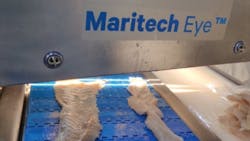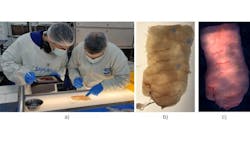Machine Vision Inspection System Detects Parasites in Cod
Researchers in Norway used a combination of hyperspectral imaging and deep learning to identify parasites in cod fillets.
Their method led to detection rates of 73%, compared to an industry average of 50% for manual inspection of fillets without skin and 25% for fillets with skin. Their algorithm has a throughput of 500 fps, which they say is fast enough for a production environment.
“Parasites in fish muscle present a significant problem for the seafood industry in terms of both quality and health and safety, but the low contrast between parasites and fish tissue makes them exceedingly difficult to detect,” write the researchers from Nofima AS, a food research institute, (Tromsö, Norway) in Scientific Reports (bit.ly/3AEHpVx).
About half of all cod has some level of infection with parasites, called nematodes, which are microscopic worm-like organisms, according to the researchers.
Related: Hyperspectral Imaging's Potential for Transforming the Imaging Field
The traditional method involves trained employees manually inspecting the fish by examining them on an illuminated table and then using a knife to trim away the parasites. The job requires long hours of standing while focusing on a detailed inspection task and performing repetitive motions with a knife.
Advantages of Hyperspectral Imaging
To automate the process, scientists have studied the use of hyperspectral imaging—which measures a multitude of wavelengths of light in each pixel, providing spectral and spatial information. Until recently, however, the equipment was too slow to keep pace with the speed of a production line, the researchers say.
The inspection system for this study includes a Maritech Eye (Molde, Norway), which has a camera, data processing unit, and interactance illumination system.
Interactance illumination, which measures how light is absorbed and reflected in a biological sample, is a crucial process for identifying the parasites because it allows users to “see” below the surface of the fish, the researchers explain.
Related: Hyperspectral Imaging Gauges Salmon Maturation for Fish Farming
The camera included in the Maritech system is a HySpex Baldur V-1024 N from Norsk Elektro Optikk AS (Oslo, Norway). The push broom camera covers the spectral range from 485-960 nm and uses line scanning to collect images.
Training and Testing the Algorithms
To test their system, the researchers prepared 289 annotated hyperspectral images of the belly region of the fish. A total of 244 parasites were identified in the images. All the data were gathered during three visits to a single factory in Portugal between December 2020 and June 2022. The images were then split into training (196 samples), validation (49 samples) and test (44 samples) data sets.
To create the data sets, humans carefully examined the fillets spending much more time per sample than is the case in production environments. They then marked the location of the parasites on digital images of the fillets using an iPad. They created the digital images by extracting RGB data from the hyperspectral images taken at the factory. They used this information to help them annotate the hyperspectral images, which they did manually using Breeze software from Prediktera AB (Umeå, Sweden), which is designed for working with hyperspectral images.
The algorithm incorporates both spatial and spectral information simultaneously to analyze the hyperspectral images of the fish, detecting the presence of parasites (or absence of them) and their location.
As noted earlier, they concluded that their automated system performed better than manual inspection at detecting the parasites. They also note that a larger sample size for training the algorithm would likely improve detection rates. More variation in the “number of nematodes, their size, species, and position in the fish muscle” also would improve detection rates, they write.
Related: Condi Food Develops Hyperspectral Imaging Sorting Solution
“These results have important implications for the seafood industry,” they conclude. “Currently, every fillet must be manually inspected for nematodes. Using hyperspectral screening, only those with fillets identified with nematodes will need to be passed along for trimming and the annotated hyperspectral images can be used to assist the trimmers in removing the parasites. This will significantly reduce labor costs and the burden on the trimmers.”
Based on the results of this work, managers at a fish-processing factory in Iceland recently installed a Maritech Eye to sort cod fillets based on the presence of nematodes, the researchers explain.
About the Author
Linda Wilson
Editor in Chief
Linda Wilson joined the team at Vision Systems Design in 2022. She has more than 25 years of experience in B2B publishing and has written for numerous publications, including Modern Healthcare, InformationWeek, Computerworld, Health Data Management, and many others. Before joining VSD, she was the senior editor at Medical Laboratory Observer, a sister publication to VSD.


